Greetings, hamster enthusiasts, and curious minds! Have you ever found yourself pondering the deep mysteries of hamster cuisine as you sprinkle a medley of seeds and nuts into your fur baby’s dish? Well, it’s time to swap that pondering for knowledge as we dive nose-first into the gastronomic world of hamsters — a place where grapes can be both friend and foe, and where the broccoli stalk walks a fine line between snack and snub.
Whether you’re a first-time hamster guardian embarking on this munchable journey, or a seasoned hamster gourmet aiming to refine your pet’s palate, we have brewed the perfect blend of information to elevate your hamster feeding game. Brace yourself as we unravel the detailed explanations behind the quiz answers, promising a feast of facts that would make even the most gourmet of hamsters squeak in approval!
Connection to the Quiz
Before we go on this delightful dining journey, we invite you to challenge yourself with our “Hamster Food Quiz: Yes or No, What Can They Munch On?” It’s a rollercoaster of multiple-choice questions, tailor-made to tease your brain and tickle your funny bone. Already took it? Mar-ham-stuous! If not, worry not; there’s still time to indulge in this delightful quiz that’s just a scroll away, waiting to welcome both novice nibblers and munchkin maestros alike.
Importance of a Balanced Diet
Now, why all this hullabaloo about a hamster’s diet, you ask? Picture this: your adorable hammy with cheeks stuffed to the brim, hiding away treasures from a perfectly balanced diet, rich in the nutrients essential for their energetic and happy lives. Yes, understanding a hamster’s dietary needs is more vital than finding that lost piece of broccoli under the fridge!
A balanced diet is not just about keeping those pesky vet visits at bay. It’s the golden ticket to witnessing your hamster flourish, with a shiny coat, bright eyes, and an endless supply of energy for nocturnal wheel runs. You see, being at the helm of your hamster’s dietary choices gives you the power to gift them a life brimming with health and happiness.
So, with the spirit of culinary curiosity ignited, let’s roll up our sleeves and dive deep into the enchanting world of hamster gastronomy, unveiling the secrets behind every yes and no in our hamster food quiz.
There you have it, the starter to our main course of knowledge that awaits. Are you ready to embark on this culinary exploration? SmartyPaws says, ‘Be curious, be clever, and always be a paw-sitive quizzer!’
Breakdown of the Quiz Questions
Grapes
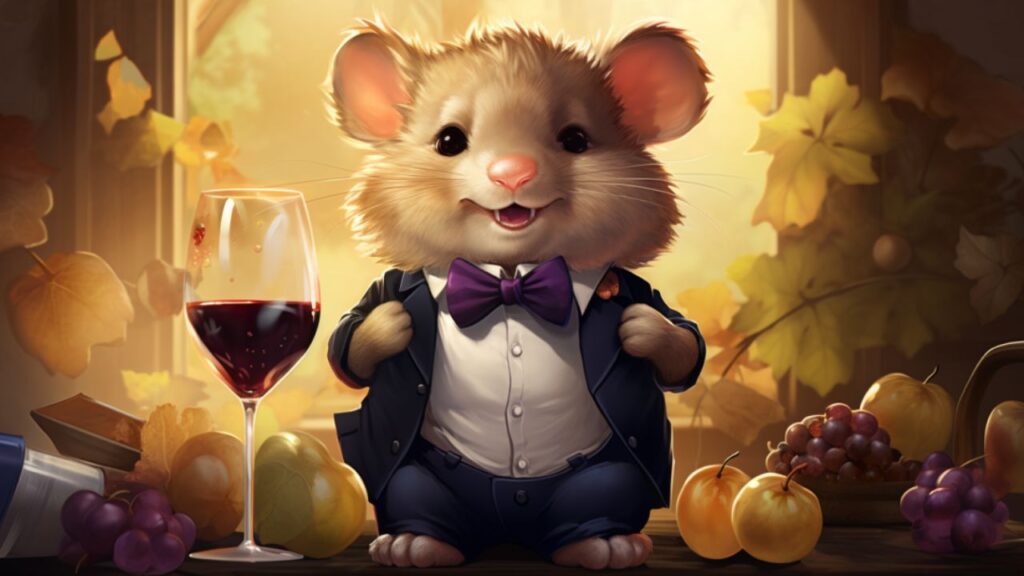
Oh, grapes, those tiny globes of juicy delight that even the ancient Romans couldn’t resist! But when it comes to sharing them with our petite furry friends, how do we fare? Let’s dissect the grape saga for our delightful little rodent companions:
Benefits and Hazards
Before you go grape galore on your hamster, let’s play a little game of pros and cons.
Pros:
- Nutrient-Rich: Grapes come packed with vitamins and minerals essential for your little furball, providing a good dose of vitamin C and antioxidants.
- Hydration: Being high in water content, they can contribute to keeping your hamster hydrated, especially in small, controlled portions.
Cons:
- Sugar Content: These tiny balls of sweetness come with a high sugar content, which can be detrimental to your hamster’s health, leading to obesity and diabetes.
- Pesticides: Grapes often come laced with pesticides which can be harmful to hamsters. Hence, always opt for organic grapes and wash them thoroughly before serving.
Proper Serving Size
Now that we’ve dabbled in the fine print of grape benefits and hazards, let’s address the grand question: how much is too much?
When introducing grapes or any new food item into your hamster’s diet, it’s wise to start with baby steps, literally. Offer them a tiny piece of grape, about a quarter of a teaspoon, to start with. This should be more than enough for their little stomachs. Monitor their reaction to ensure they don’t experience any digestive discomfort.
It’s essential to ensure that grape treats remain just that, treats! Incorporating them in their diet not more than once a week is a good rule of thumb to follow, giving your hammy a delightful little surprise without overloading their system.
Also, remove any uneaten grape portions after a few hours to prevent them from spoiling and turning into a potential health hazard.
SmartyPaws says, ‘Moderation is the key to a grapey-success in the hamster world!’ So, proceed with caution and watch your hamster enjoy this royal treat in the healthiest way possible!
Balanced Diet

When it comes to serving up a five-star diet for your fluffy roommate, striking the right balance is the secret ingredient to keeping those tiny whiskers twitching with delight. Let us break down the haute cuisine of the hamster world, one component at a time.
What it Should Include
Every culinary maestro knows that variety is the spice of life, and hamsters are no different. Crafting a balanced diet for your hammy involves blending a rich tapestry of nutrients to ensure they get a little bit of everything they need to thrive. Here’s what a hamster’s balanced diet should include:
- Proteins: Hamsters are partial to proteins, and it should constitute about 17-22% of their diet. You can offer them animal proteins like chicken or turkey, boiled or cooked without any spices. Insects like mealworms and crickets are also hamster favorites!
- Fibers: To keep their digestive system running smoothly, a diet high in fiber is essential. Incorporating a variety of vegetables like broccoli, carrots, and cucumbers can do the trick.
- Carbohydrates: These should be the mainstay of your hamster’s diet, constituting about 50-60%. Whole grains like barley, oats, and wheat are excellent sources of carbs.
- Fats: Although hamsters have a fondness for fatty foods, it should only take up a small portion of their diet, around 5%. Seeds and nuts can be a source of healthy fats, but more on that in a jiffy!
- Vitamins and Minerals: These can be found in a range of fruits and vegetables, providing the nutrients they need to maintain a healthy body and mind. Think along the lines of vitamin A from carrots and vitamin C from apple slices (sans seeds!).
And let’s not forget fresh water, the elixir of life, readily available in their habitat to wash down this gourmet feast!
The Role of Seeds and Nuts
Ah, seeds and nuts, the titbits that can turn any hamster into a food critic, discerning the delightful from the downright mundane! But what role do these crunchy delights play in a balanced diet?
- Source of Healthy Fats: While seeds and nuts are high in fats, they offer the kind of healthy fats essential for your hamster’s well-being, nurturing shiny coats and aiding cell function.
- Nutritional Powerhouses: Many seeds and nuts are rich in vitamins and minerals, providing a nutritious crunch to your hamster’s diet.
- Foraging Fun: Scattering a few seeds and nuts around your hamster’s enclosure can encourage their natural foraging instincts, giving them both mental and physical stimulation.
However, one should tread this path with caution. Seeds like sunflower and pumpkin seeds are high in fats and should be given sparingly to avoid obesity. And nuts, though nutritious, are calorically dense and should be offered as occasional treats rather than a daily snack.
Balancing the act of serving seeds and nuts is akin to perfecting a fine dish, a sprinkle here, a dash there, to create the perfect harmony of taste and nutrition, paving the path for a happy, healthy hamster gourmet journey!
Citrus Fruits
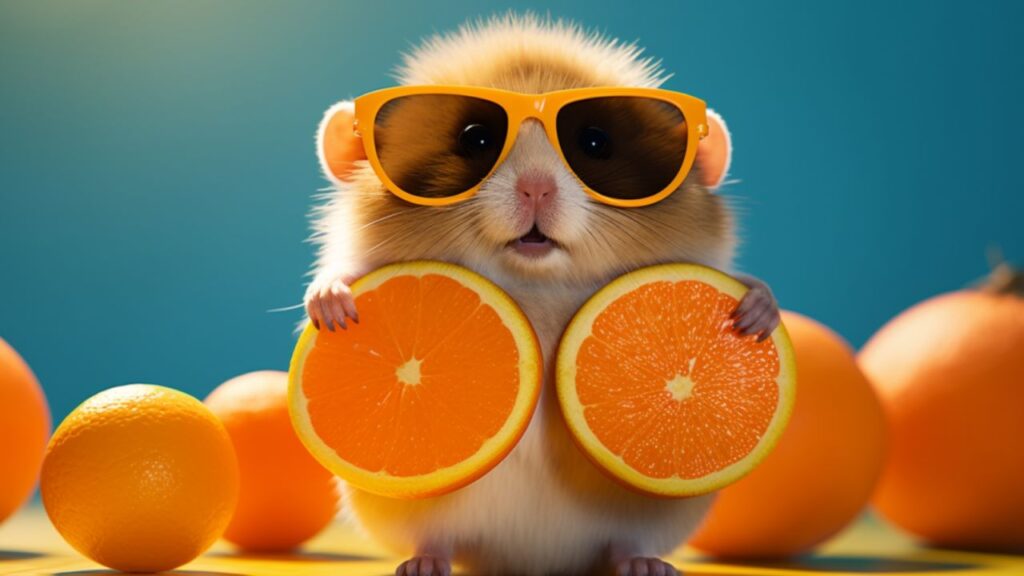
As we venture further into the enticing world of hamster gastronomy, we come face to face with the vibrant, zesty, and tantalizing group known as citrus fruits. But hold your horses, dear hamster enthusiasts, for these bright orbs hold secrets that might not be too pleasing to our furry friends’ delicate systems. Let’s unravel the citrus conundrum, shall we?
Why They are a No-Go
Now, while a splash of lemon might elevate many a human dish to the realm of the extraordinary, for hamsters, it’s a highway to discomfort city. Here’s why:
- High Acidity: Citrus fruits are notorious for their high acidity levels. This acidity can cause havoc in a hamster’s digestive system, leading to upset stomachs and even ulcers.
- Vitamin C Overdose: Though vitamin C is vital for hamsters, citrus fruits offer it in quantities far too generous, leading to an overload which their tiny bodies can’t handle, resulting in health complications.
- Potential Allergies: The vibrant peels of citrus fruits contain compounds that can potentially trigger allergic reactions in hamsters, leading to itchiness and discomfort.
It’s safe to say that while citrus fruits may be a festival of flavors and vitamins for humans, they play the role of a villain in the petite world of hamster diets.
Alternatives to Citrus Fruits
Fear not, dear hamster connoisseurs, for the world of fruits is rich and varied, offering a bounty of options that are both safe and delightful for our little munchkins. Here are some hamster-approved alternatives to citrus fruits:
- Apples: Offering a crunch and a splash of sweetness, apples (sans seeds) can be a great alternative. They offer hydration and a dose of vitamins to boot!
- Pears: Soft, sweet, and packed with nutrients, pears make for a great citrus alternative, presenting a mild flavor that’s easy on the hamster’s digestive system.
- Bananas: In small amounts, bananas can be a sumptuous treat, offering a creamy texture and a punch of energy, thanks to its natural sugars.
- Blueberries: These little orbs of sweetness not only offer a tasty treat but come packed with antioxidants, promoting overall health for your furry friend.
Remember, when introducing any new food into your hamster’s diet, start with small quantities to see how they react and always ensure the fruits are fresh and free from any pesticides or harmful chemicals.
Broccoli

As we steer our gourmet journey to the green and vibrant land of broccoli, it’s time to evaluate whether this vegetable, often deemed as a superfood for humans, holds the same stature in the hamster dietary chart. Without further ado, let’s dissect the broccoli dossier for our whiskered companions:
The Good and the Bad
Ah, broccoli, the miniature tree-like veggie that’s a powerhouse of nutrients but also comes with its own set of caveats for our furry friends. Let’s lay down the good and the bad for a rounded view:
The Good:
- Rich in Vitamins: Broccoli is a rich source of vitamins like Vitamin C and Vitamin K, ensuring that your hamster has a strong immune system and healthy bones.
- Dietary Fiber: The high fiber content in broccoli aids in smooth digestion, promoting a healthy gut for your little one.
- Hydrating: Being high in water content, a small serving of broccoli can aid in keeping your hamster hydrated.
The Bad:
- Gas and Bloating: While it is a nutritious choice, broccoli can cause gas and bloating in some hamsters, leading to discomfort.
- Oxalates: Broccoli contains oxalates, which can interfere with the absorption of certain minerals, potentially leading to health issues in the long term if not balanced with other foods.
- Pesticides: Like other veggies, broccoli can come with pesticides. Always opt for organic choices and wash it thoroughly before serving it to your pet.
How to Serve It
Serving broccoli to your hamster is akin to presenting a gourmet dish, with a focus on freshness, cleanliness, and the right portion size. Here’s the roadmap to serving the perfect broccoli dish to your hamster:
- Clean Thoroughly: Start by washing the broccoli under cold water to remove any pesticides and dirt.
- Steaming is Key: While raw broccoli is fine, steaming it slightly can make it easier to digest for your little furball. However, ensure it is cool before serving.
- Small Portions: Hamsters are tiny creatures with even tinier stomachs. Serve a small portion, about the size of their head, to ensure they don’t overeat.
- Supervise: Always supervise your hamster when introducing new foods to their diet and check for any signs of discomfort or allergies.
- Remove Leftovers: To maintain hygiene, remove any uneaten portions after a few hours to prevent them from spoiling and turning into a potential health hazard.
So, turn your hamster’s habitat into a gourmet restaurant, serving them the finest broccoli dish, prepared with care and affection.
Meat in a Hamster’s Diet
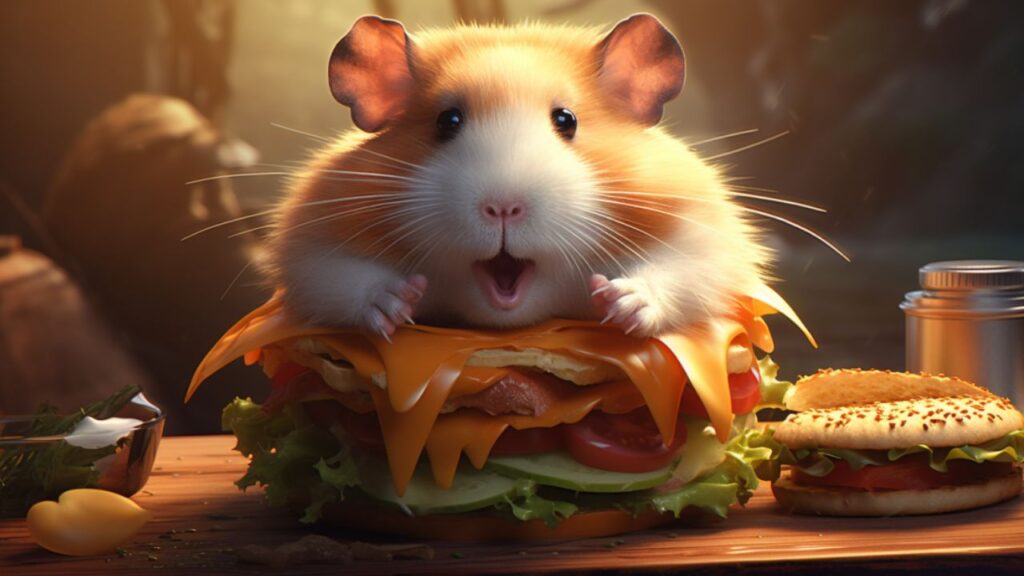
Next on our culinary voyage through the diverse landscape of a hamster’s diet is a stop at the protein-packed station of meats. Yes, our little furballs do have a penchant for some meats, taking their diet to a gourmet level with a bit of safe and well-prepared non-vegetarian fare. Let’s delve into the meaty details of including this protein source in your hamster’s dining menu.
The Kind of Meat that is Safe
Before you rush to share your steak with your hamster, let’s discuss the kind of meats that are actually safe for their consumption:
- Poultry: White meats such as chicken and turkey are safe bets when it comes to feeding your hamster. These meats are low in fat and easy to digest, making them suitable for your pet’s dietary needs.
- Insects: While not exactly ‘meat,’ insects like crickets and mealworms are a natural source of protein for hamsters. You can find specially prepared insect treats for hamsters at pet stores.
- Cooked Lean Meats: If you prefer serving traditional meats, opt for lean cuts that are cooked plainly without any spices or seasonings to avoid upsetting your hamster’s delicate digestive system.
Remember, the kind of meat that is safe excludes any form of processed meats (like ham, bacon, or sausages) due to high salt and fat content, which are unhealthy for your little friend.
The Right Way to Serve It
Now that we have identified the safe options, it’s time to garnish them with the right preparation method:
- Cooked and Plain: Always serve meats cooked and plain, devoid of any spices, salts, or oils. The goal is to retain the natural goodness without any additives that might harm your hamster.
- Small Dices: Hamsters are small creatures with petite appetites, so serving the meat in small, bite-sized dices will ensure easy consumption.
- Fresh Not Frozen: While it might be tempting to store meats for longer periods, always opt for fresh servings to avoid any bacterial growth that can occur in thawed meats.
- Occasional Treat: Incorporating meat into your hamster’s diet should be done occasionally to supplement their protein intake, and not as a daily affair.
- Clean-Up: Just like with any other fresh food, remove any uneaten meats from your hamster’s habitat promptly to maintain cleanliness and prevent the growth of bacteria.
So, put on your chef’s hat and prepare a sumptuous meaty treat, but remember, moderation is key in ensuring a healthy and happy gourmet journey for your hamster.
Seeds

As we forge ahead in our gastronomic journey tailored for the tiny connoisseurs with fur and whiskers, we stumble upon the crunchy, munchy world of seeds. They are a staple in the hamster diet but not all seeds are created equal. So, grab your notepads, fellow hamster caretakers, as we delve into the particulars of safe and unsafe seed choices for our little gourmands.
Which Seeds to Avoid and Why
In the sea of seeds available, there are some that we must vehemently avoid to keep our fluffy pals in the pink of health. Let’s sow the seeds of knowledge and find out which ones to avoid and why:
- Apple Seeds: They contain amygdalin, a substance that releases cyanide when digested. Definitely a big no-no for your little one.
- Citrus Seeds: Citrus seeds not only inherit the acidity of the fruits but also contain small amounts of toxins, making them unsuitable for your pet.
- Cherry Pits: Just like apple seeds, they contain cyanogenic glycosides which can be harmful to your hamster.
- Peach and Plum Pits: These pits carry the risk of choking and also contain harmful substances that can adversely affect your hamster’s health.
Clearly, the seed world is fraught with dangers hiding in pretty packages, making it imperative to be well-informed and cautious.
Safe Seed Options
But fear not, seed aficionados, for the world of seeds still holds treasures that are both safe and nutritious for our hamster heroes. Let’s unveil the seed stars of the hamster diet:
- Sunflower Seeds: A classic favorite, these seeds are rich in oils and can be a great energy source, but due to their high-fat content, they should be offered in moderation.
- Pumpkin Seeds: Not only are they safe but they come packed with nutrients that are beneficial for your hamster, offering a delightful crunch with every bite.
- Sesame Seeds: In small quantities, sesame seeds can be a good source of nutrients, offering a variety of minerals beneficial to your hamster’s health.
- Flax Seeds: These are a powerhouse of nutrients, offering a rich source of omega-3 fatty acids which are great for your hamster’s coat and overall health.
Remember to always offer seeds unsalted and in moderation, ensuring a balanced diet that is rich in variety and nutrients, giving your hamster a banquet fit for a king.
Essential Nutrients

Our gastronomic journey has brought us to the pivotal point where we get down to the nitty-gritty of nutrients. Specifically, we’re shining the spotlight on proteins – the building blocks of life, essential not just for humans but for our whisker-twitching companions as well. Let’s explore the empire of proteins, carving out the way for a hamster’s diet rich in muscle-building elements, and ensuring they flex those tiny muscles with vigor!
The Importance of Proteins
As we lift the curtain on proteins, it is pivotal to underline why these nutrients are the showstoppers in the dietary theater of a hamster:
- Growth and Development: Proteins aid in the healthy growth and development of hamsters, especially during their juvenile stage, facilitating proper muscle and tissue formation.
- Cell Repair and Maintenance: They play an indispensable role in cell repair and maintenance, ensuring your fur baby stays in prime condition as they age.
- Immune Health: Proteins support the immune system, helping to fend off illnesses by strengthening the body’s natural defenses.
- Energy Source: Beyond just building muscles, proteins serve as a considerable energy source, keeping your hamster energetic and lively, ready to run those wheels night after night!
Thus, incorporating a balanced amount of protein in a hamster’s diet is not just beneficial, but a non-negotiable aspect of ensuring a healthy and vivacious life for your pet.
Sources of Good Proteins for Hamsters
Now that we’ve sung the praises of proteins, it’s time to map out the treasure trove where these nutrients can be sourced for a gourmet hamster diet:
- Insects: Mealworms, crickets, and even earthworms, are natural, protein-rich foods for hamsters. Available in pet stores, these can be served as treats, offering not just protein but an exciting culinary adventure for your pet.
- Lean Meats: As discussed earlier in our meaty chapter, lean meats such as chicken and turkey served cooked and unseasoned are great protein sources.
- Legumes: Boiled soybeans and lentils can be a great addition, offering a plant-based protein source that is easy to digest and rich in nutrients.
- Dairy: In small quantities, dairy products such as low-fat, unsweetened yogurt can be a delightful protein-packed treat for your hamster.
Bear in mind to always introduce new protein sources gradually and in moderation to steer clear of digestive upsets.
Vegetables
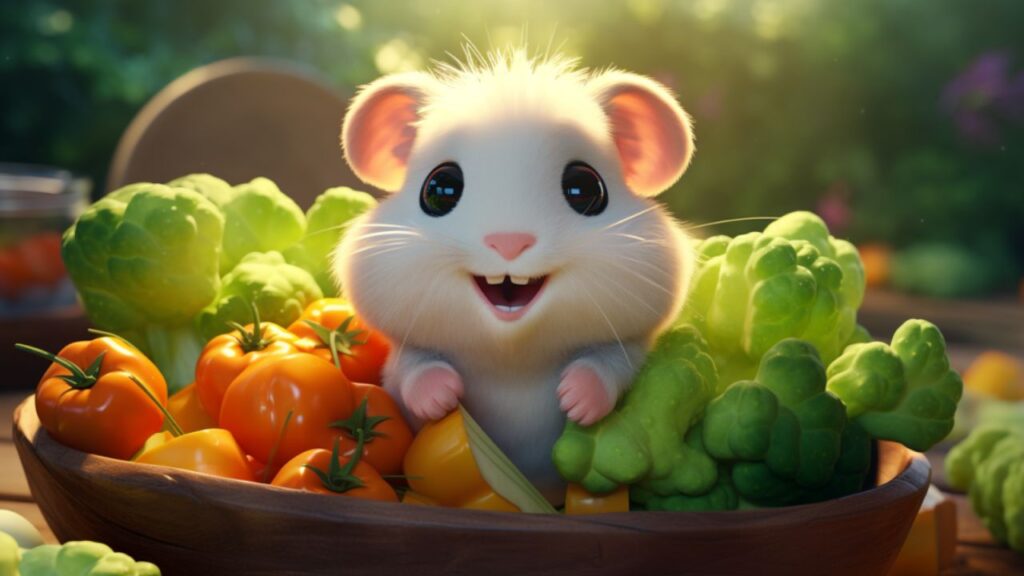
Oh, veggies, the vibrant, crunchy cornerstones of every well-balanced diet! They bring a burst of color and a wellspring of nutrients to our hamsters’ dinner tables, but navigating through the wide array of vegetables to discern what suits our tiny gourmands can be a bit of a jungle. Fear not, for we are about to embark on a veggie venture, identifying the heroes and the villains in the vegetable aisle for our whiskered friends.
Which Veggies to Avoid
In the lavish vegetable buffet laid out for hamsters, there exist certain items that must remain untouched, as they carry potential risks and adverse effects. Let us demystify which veggies to steer clear from:
- Onions and Garlic: These strong-flavored veggies can cause digestive upset and are generally avoided in a hamster’s diet.
- Potatoes: They are rich in starch which can be difficult for hamsters to digest, not to mention the risk of solanine poisoning in green and sprouting potatoes.
- Tomatoes: While not exactly harmful, the high water content in tomatoes can cause diarrhea, making it advisable to avoid them.
- Spicy Peppers: These veggies can irritate the hamster’s digestive system and hence, it is best to avoid feeding them spicy peppers.
The golden rule? If a vegetable has a strong flavor or a high water content, it’s likely better left off your hamster’s dinner plate to avoid digestive troubles.
Hamster-friendly Veggies
Now, let us weave through the garden of delights to handpick the gems that are not just safe but enthusiastically enjoyed by hamsters:
- Broccoli: Though it can be a bit gassy, serving it in moderation can be a delightful addition to your hamster’s diet, offering a rich source of fiber and nutrients.
- Carrots: A favorite amongst many hamsters, carrots are rich in beta-carotene and offer a delightful crunch, but should be given in small amounts due to high sugar content.
- Cucumbers: A great hydrating snack, especially during the summers, cucumbers should be given in moderation to avoid diarrhea due to high water content.
- Peas and Zucchini: These veggies are rich in nutrients and are generally well-tolerated by hamsters, making them a great addition to their diet.
Remember, the mantra is fresh and clean. Always serve veggies that are fresh and thoroughly washed to remove any traces of pesticides or chemicals.
Balanced Hamster Diet
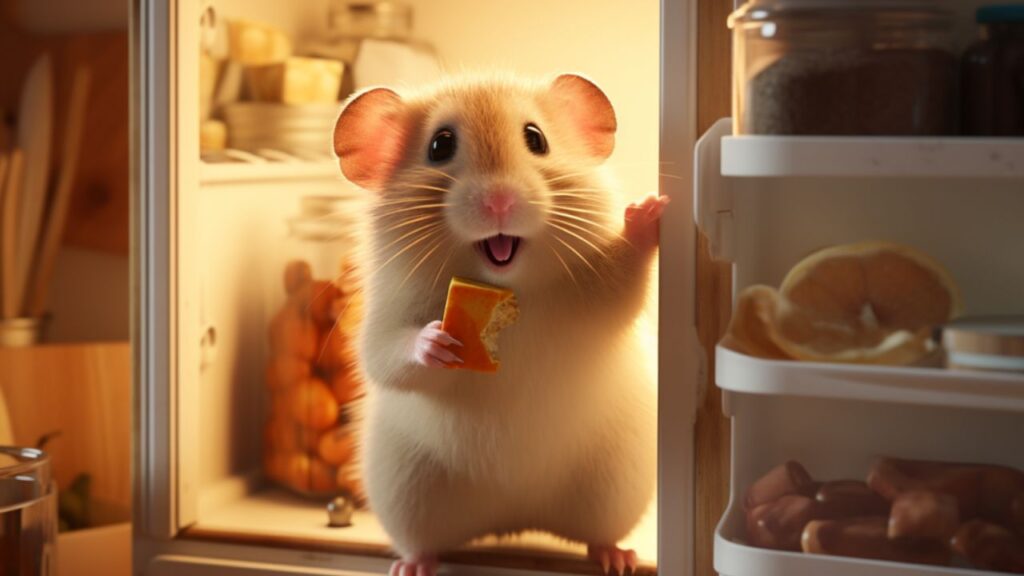
As we inch closer to the grand finale of our hamster culinary journey, it is time to put all the pieces of the puzzle together and craft a diet that is as balanced as a tightrope walker at a circus — steady, varied, and with a sprinkle of excitement. Let’s dissect the science and the art of orchestrating a balanced diet for our furry maestros, ensuring a lifetime of wellness with every nibble.
Importance of Variety in a Hamster’s Diet
A monotonous diet can be a droll, even for the tiniest creatures. Ensuring variety in a hamster’s diet goes beyond merely offering gastronomic pleasure; it has deep-rooted benefits:
- Nutrient-Rich: A diverse diet ensures that hamsters receive a rich array of nutrients, catering to their holistic health needs.
- Behavioral Enrichment: Variety encourages natural foraging behaviors, offering a delightful play of textures, flavors, and smells, thus enriching their daily experiences.
- Prevents Selective Eating: Hamsters are known to be selective eaters. A varied diet helps to break this pattern, ensuring they consume a balance of all necessary nutrients.
- Better Immunity: A diet rich in various nutrients aids in building a robust immune system, helping the hamster ward off illnesses effectively.
Thus, spicing up your hamster’s diet with an array of options is not just a treat for their taste buds but a boon for their overall well-being.
Tips to Balance it Right
Crafting a balanced diet is an art, and we’re here to help you paint a masterpiece with the following tips:
- Start with a Good Base: Offer a high-quality hamster mix as a base, ensuring it covers the basic nutritional needs, including proteins, fibers, and vitamins.
- Fresh Foods in Moderation: Incorporate a blend of fresh foods, from veggies to proteins, but always in moderation to avoid digestive issues.
- Hydration is Key: Ensure a constant supply of fresh and clean water to aid in digestion and maintain hydration.
- Limit Treats: While treats can be a delightful addition, they should be limited to avoid obesity and other health issues.
- Consult a Vet: If in doubt, always consult a vet to understand the specific dietary needs of your hamster, tailoring a diet that suits them best.
Remember, it’s all about balance — offering a kaleidoscope of nutrients without going overboard, maintaining the delightful equilibrium of health and happiness.
Treats

Ah, the grand finale in the gastronomic odyssey of our furry little gourmands – treats! This section is the proverbial cherry on top, where we get to indulge our pet hamsters with goodies that not only tickle their taste buds but also nourish their playful spirits. However, as every connoisseur would agree, not all treats are created equal. Let us navigate the delicate balance between indulgence and nourishment in the world of hamster treats.
Recommended Treats
In the glittering galaxy of hamster treats, there are a few stars that shine brighter, offering not just tantalizing tastes but also a wealth of nutrients:
- Berries: Blueberries, strawberries, and raspberries offer a sweet and nutritious treat that is generally well-received by hamsters. Remember to serve them fresh and in small quantities.
- Unsalted Nuts: While we have delved into the world of seeds and nuts, let’s not forget that unsalted nuts like almonds and walnuts can be a delightful treat, offering a satisfying crunch and healthy fats.
- Cooked Plain Eggs: A small piece of boiled egg can be a protein-packed treat that is both nourishing and delicious.
- Dried Herbs: Herbs like rosemary and thyme can be offered in small amounts for a delightful treat that also aids in digestion.
Treats can also come in the form of affection and play, with food puzzle toys serving as a great way to engage and entertain your hamster while offering a tasty reward.
Treats to Avoid
While treats are a joyous occasion, there are certain delicacies that must remain off the banquet table to ensure the safety and well-being of our hamsters:
- Chocolates and Sweets: These can be harmful, leading to diabetes and obesity in hamsters.
- Citrus Fruits: As previously noted in our citrus chapter, these fruits are a no-go due to their high acidity.
- Human Snacks: Snacks like chips, pretzels, and other processed foods are laden with salts and artificial additives, making them unsafe for hamsters.
- Caffeinated and Alcoholic Substances: Needless to say, these are extremely harmful and should be strictly avoided in a hamster’s diet.
By steering clear of harmful treats and indulging in safe, nutritious goodies, we can create delightful treat-time memories filled with joy and nourishment.
Smarty’s Scoring Spectrum

As we wind down our hearty expedition through the veritable feast of hamster dietary lore, it’s time to shine a spotlight on your achievements in the grand “Hamster Food Quiz.” Whether you triumphed with flying colors or stumbled upon a culinary conundrum, the Scoring Spectrum is here to guide you to further gastronomic glory!
Connecting the Scores to the Article
Allow me to play the maestro, orchestrating a symphony of feedback tailored to your quiz performance, aligning it seamlessly with the rich tapestry of knowledge woven throughout the article:
- 0-20%: Budding Gourmet: Your culinary journey has just begun! It seems you might benefit from revisiting the sections on “Balanced Hamster Diet” and “Essential Nutrients” to build a strong foundation.
- 21-40%: Novice Nibbler: You’ve taken your first steps in the vibrant world of hamster diets. A deeper dive into “Meat in a Hamster’s Diet” and “Vegetables” could be your golden tickets to the next level.
- 41-60%: Savvy Snacker: Oh, impressive! Your hamster gastronomy skills are budding nicely. To sharpen your knowledge further, revisit the “Seeds” and “Citrus Fruits” segments and watch your expertise grow.
- 61-80%: Gourmet Guru: Wowza, you’re nearly a master of hamster cuisine! Fine-tune your skills by brushing up on “Broccoli” and “Treats” segments, and you’ll be a maestro in no time!
- 81-100%: Culinary Connoisseur: Standing ovation! You have mastered the fine art of hamster gastronomy. Your deep understanding of the “Balanced Hamster Diet” and “Essential Nutrients” segments showcases your expertise. Share your knowledge and guide others on this culinary trail.
Extra Tidbits
As a treat for our curious quizmasters, here are some fascinating trivia nuggets that we didn’t get to sprinkle into our quiz:
- Hamster Cheek Pouches: Did you know hamsters have cheek pouches that extend to their hips, allowing them to store a smorgasbord of food to enjoy later? Truly nature’s takeaway bags!
- Wild Diets: In the wild, hamsters are known to feast on a range of insects, providing them with essential proteins. However, in the cozy confines of your home, this can be substituted with lean meats and poultry.
- Seasonal Foods: Wild hamsters alter their diets according to the season, munching on seeds and grains in the summer and storing them for a wintertime feast, showcasing their adaptability and planning prowess.
Remember, the path to culinary mastery is paved with curiosity, exploration, and a dash of fun!
Conclusion

Well, brave culinary explorers, we have navigated the gastronomic galaxy of hamster nutrition, a universe sprinkled with crunchy seeds, infused with the vibrant hues of fresh veggies, and adorned with the finest gourmet treats reserved for our fluffy gastronauts. It has been a journey from the citrus groves (best admired from afar) to the vibrant patches of safe-to-nibble broccoli gardens.
From unraveling the hamster-approved meat menu to understanding the must-have nutrients, we’ve embarked on a grand tour, with your culinary cart now brimming with knowledge to whip up a hamster feast that speaks both elegance and wellness.
Recap
As we dust off our chef hats and hang up our aprons, let’s take a moment to reminisce over the smorgasbord of knowledge we’ve prepared today. From understanding the delicate ballet between the essential nutrients to crafting a symphony of flavors with safe fruits and veggies, we’ve turned into veritable hamster gourmets, haven’t we?
We sailed the citric seas, maneuvering skillfully to avoid the stormy waves of high acidity and ventured into the vibrant fields of broccoli, where the greens beckoned with promises of health, balanced with a whisper of caution.
Encouragement
Now, delightful readers, as you stand before your hamster’s abode, armed with a rainbow of nutritional wisdom, remember, the world of hamster gastronomy is as expansive as your curiosity allows it to be.
So, we encourage you to keep the spirit of culinary adventure alive, diving deeper, learning continuously, and turning each feeding time into a festival of flavors, a carnival of nutrients, where the star of the show is your little furry friend, savoring the delights created with love, care, and an armory of knowledge.
Your newfound wisdom is not just a token of pride but a bridge to a happier, healthier life for your tiny companion. So, keep exploring, keep experimenting, and remember that every grain of knowledge adds spice to the grand feast of life.




